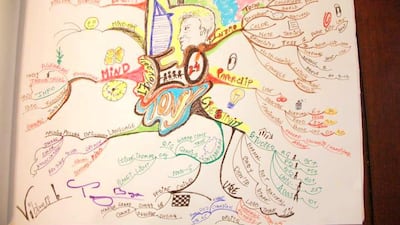Most parents would love to see their children grow up to become the next Mozart, Einstein or Da Vinci. Few of them do, but according to Tony Buzan, the UK-baed pioneer of mind mapping as a learning tool to help the brain learn and recall information– every child is born to be brilliant.
And the best way to insure your child grows up to fulfill their creative potential, he claims, is to teach them to learn with mind maps, rather than standard, linear note-taking.
What is a mind map?
Mind maps are a type of spider diagram, using images, rather than words, to depict connections and ideas. The technique is now practised by over 250 million people worldwide for tasks including brainstorming, identifying new opportunities, organising, studying and communicating information.
“Mind maps are like a city map,” says Buzan. “When you go to a new city, you need a map so you can find the routes where you can go. Mind maps let you guide your mind through the map, which is the city of your thinking.”
Buzan says it’s best to start early – he recommends parents draw up mind maps for babies and hang them in the nursery.
“Lets say the baby becomes interested in a dog,” he says. “You can make a little drawing of a dog in the centre, with the baby watching you drawing it. Then you add branches: ‘Fur’ – ‘Smooth.’ ‘Friend – Cuddle’. Babies immediately understand mind maps.”
The workshop
On Saturday, Dubai-based mind mapping enthusiast Vibhuti Mutha, 32, will be instructing children between the ages of 8 and 14 during a one-off , four-hour class in Dubai.
Mutha, from India, was first introduced to mind mapping 10 years ago, when she worked as an events manager in an office where mind maps were pinned onto the walls.
“I became intrigued,” she says. “I’m an also artist, so colours and images attract me. I started googling mind maps and after a year, I’d made over 100 mind maps of my own.”
Mutha received training by Buzan on one of his regular trips to Dubai in 2011, and since then has been sharing her skills with both corporates and children.
“I love teaching kids because if they learn it at an early stage, mind mapping can really help them, not just in school but in life,” she says.
A whole new world
Mutha introduces children to the concept with basic brainteasers; children write their name, using images to replace at least three of the letters.
“That gets them thinking,” she says. “I give an example by writing on the board my own name – for example, ‘T’ becomes a teacup, and ‘B’ becomes a bee. The kids come up with wonderful ideas, and it gets them excited because it is fun.”
The best thing is, written words are kept to a minimum.
“Your brain is not bombarded with lots of information,” says Mutha, “which makes it easy to access, understand and analyse that information. It gets your brain intuitive, interested and more creative in what you’re doing.”
Some children are initially reluctant, says Mutha, as they’ve been persuaded to come along by their parents. “It takes half an hour for those children to really start getting excited about it. But at the end of the day, they all leave happy.”
• The Mind Mapping for Kids workshop is on Saturday, February 6, from 9am to 1pm at Villa Rotana, Sheikh Zayed Road, Dubai. Dh600 per child, includes learning materials, refreshments and certificate. Visit projectpurpose.ae to register
artslife@thenational.ae
Vibhuti Mutha on how to make a mind map in seven easy steps
1 Start in the centre of a blank page placed horizontally. This gives your brain freedom to spread out in all directions and express itself more freely.
2 Use an image or picture for your central idea. An image helps you use your Imagination. A central image is more interesting, keeps you focused, and gives your brain more of a buzz.
3 Use colours throughout. Colour adds life to your mind map, energy to your creative thinking, and is fun.
4 Connect your main branches to the central image and connect your second and third-level branches to the first and second levels. Your Brain works by association. It likes to link two (or three or four) things together. If you connect the branches, you will understand and remember more easily.
5 Make your branches curved rather than straight-lined. Having nothing but straight lines is boring to your brain.
6 Use one key word per line. Single key words give your mind map more power and flexibility.
7 Use images throughout. Each image is also worth a thousand words.

